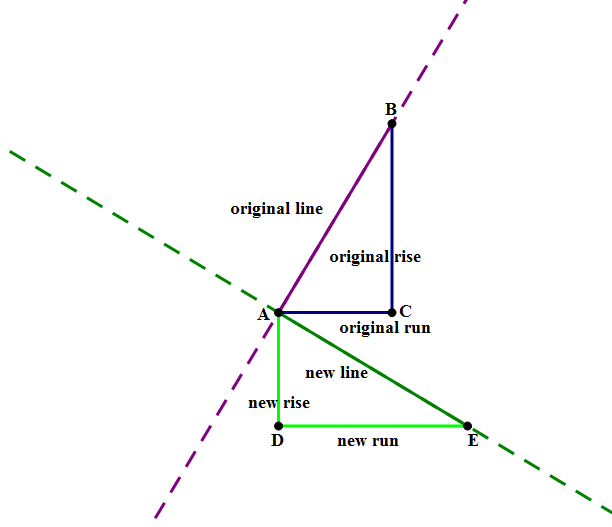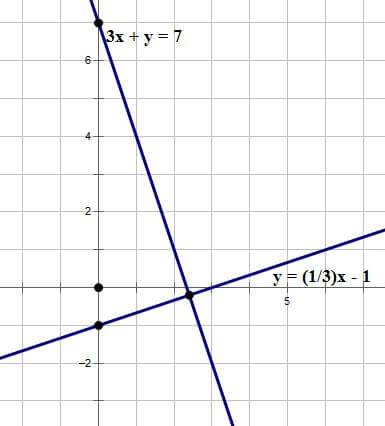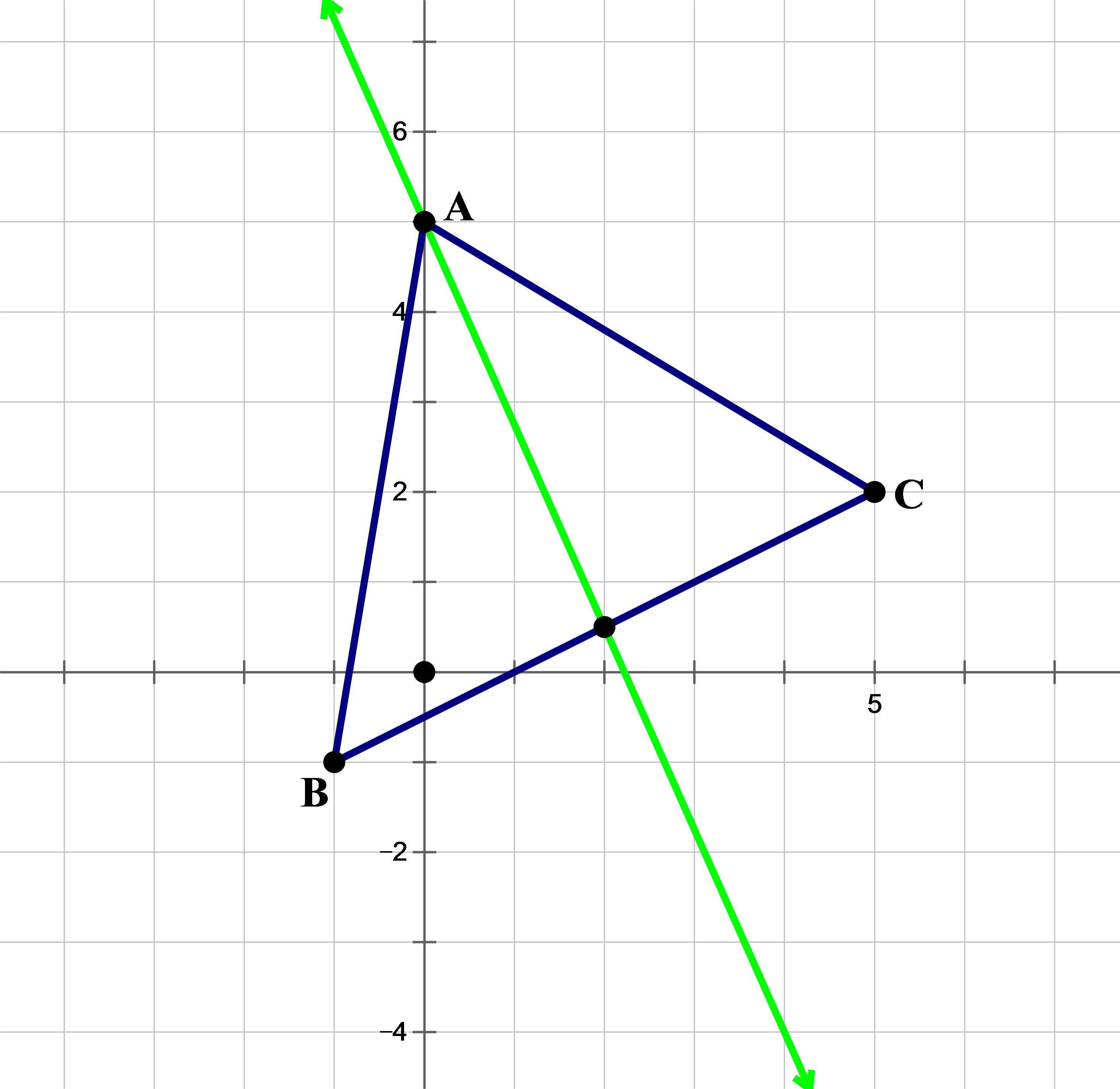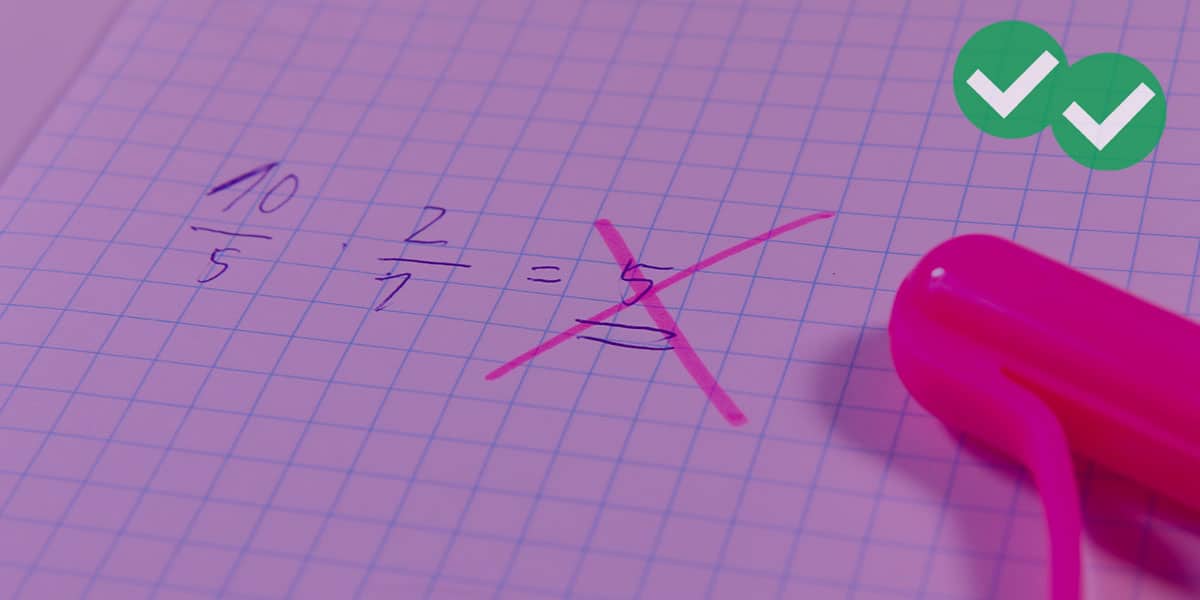First, a few practice questions.
1) Line A has the equation 3x + y = 7. Which of the following lines is perpendicular to Line A?
-
(A) y = 3x + 4
(B) y = –3x – 6
(C) y = (1/3)x – 1
(D) y = (–1/3)x + 2
(E) y = (–7/3)x – 5
2) Line P has a positive slope and a positive y-intercept. Line Q also has a positive slope and a positive y-intercept. The two slopes and the two y-intercepts are four different numbers, none equal. Lines P & Q have a single intersection point — what is the full set of possible quadrants in which the intersection point could be?
-
(A) I only
(B) I & III only
(C) I & II only
(D) I & II & III only
(E) all four quadrants possible
3) The median of a triangle is the line from any vertex to the midpoint of the opposite side. Triangle ABC has vertices A = (0, 5), B = (–1, –1), and C = (5, 2). What is the slope of the median from A to the midpoint of BC?
-
(A) –3/4
(B) >–4/3
(C) –5
(D) –5/2
(E) –9/4
Slope of horizontal and vertical lines.
In the previous post, I discuss the idea of slope, but I didn’t talk about the special cases of horizontal and vertical lines.
A horizontal line is all run and no rise: therefore, its slope, its rise/run, is zero. By contrast, a vertical line is all rise and no run — when we calculate its rise over run, we get a mathematical error, because we can’t divide by zero. This means, vertical lines have undefined slope; very roughly, we can think of vertical lines as having “infinite” slope, although technically, that way of interpreting vertical lines does not bear rigorous analysis of the idea of infinity —- which, of course, is well beyond anything on the GMAT.
Horizontal lines have a slope equal to zero. Vertical lines have an undefined slope: the value of their slope does not make any mathematical sense. I would strongly recommend against saying that either has “no slope”, because that is a term ripe for confusion: does “no slope” mean a slope with a value of zero or does it mean not being able to compute the value of the slope? I recommend that you absolutely banish the term “no slope” from your vocabulary.
Parallel and perpendicular lines
Parallel lines in the x-y plane have equal slope. If the think about what the slope means geometrically, you will see that this has to be true. The GMAT expects you to know this.
The case with perpendicular lines is a little trickier. Let’s think about this. Consider any slanted line with a positive slope (i.e. moving up to the right) — then the line perpendicular to it will have to have a negative slope (i.e. moving down to the right, moving up to the left). Similarly, if the original line has a negative slope, the perpendicular would have to have a positive slope. Thus, the slope of a perpendicular line is always has a sign opposite of the sign of the original line. That’s part one of the idea.
Now, let’s think about if we take a “rise over run triangle” and rotate it 90°. Let’s ignore ± signs for a moment, and just think about absolute values.
So, we have two perpendicular lines, the original line AB and the perpendicular line AE, intersecting at point A. For each, we have constructed “rise over run” triangle for the slope. The slope of line AB = (original rise)/(original run) = BC/AC, and the slope of line AE = (new rise)/(new run) = AD/DE. But notice that these two triangles are congruent! Triangle ADE is just Triangle ACB rotated 90° around point A. Because the triangle are congruent, the corresponding lengths are equal: AC = AD and BC = DE. In other words, the rise of one is the run of the other! When we go from the original line to a line perpendicular to it, the rise and the run switch places in the slope fraction. When the numerator and denominator of a fraction switch places, that’s called a reciprocal. For example, 2/5 and 5/2 are reciprocals; 3/11 and 11/3 are reciprocals; 7 and 1/7 are reciprocals.
Now, put these two facts together — when line #1 has a slope, and line #2 is perpendicular to it, the slope of line #2 must have both the opposite sign from and must be a reciprocal of the original slop of line #1. More elegantly, perpendicular slopes are opposite reciprocals. The GMAT expects you to know this.
If one line has a slope = +4/7, then the perpendicular line has a slope = –7/4. If one line has a slope of –3, the perpendicular line has a slope = +1/3. If you know the slope of one line, you flip that fraction over and change its sign to the opposite to make the slope of the perpendicular line. If this is a new idea to you, or one which learned but forget a long time ago, then I strongly recommend you actually get some graph paper and actually graph sets of perpendicular lines and find their slopes, so you have a visual understanding of this idea.
Midpoints
Occasionally, the GMAT will ask to you to find the coordinates of the midpoint of a segment. You will be given the two endpoints of the segment — for example, (4, 1) and (10, 15). You find the coordinates of the midpoint by averaging the values they give you. The x-coordinate of the midpoint is the average of the x-coordinates of the end points; here, this average is (4 + 10)/2 = 7. Similarly, the y-coordinate of the midpoint is the average of the y-coordinates of the end points; here, this average is (1 + 15)/2 = 8. Therefore, the coordinates of the midpoint are (7, 8). If you can take an average —- twice —- then you can find the coordinates of a midpoint.
Final Thoughts
Any question about any points or lines in the x-y plane is a visual question. If you are not given a diagram, always sketch a diagram. You open up a whole new level of understanding when you add a visual approach.
If the two practice questions at the top gave you some difficulty when you first looked at them, now that you have read this article, take another look at them before you jump into the explanations below.
Practice problem explanations
1) What’s tricky about this problem: we have to begin by solving the given equation for y, so that we know its slope.
The slope of the original line is m = –3, and the negative reciprocal of that is +1/3, so the perpendicular line must have a slope of +1/3. Among the answer choices, the only line with a slope of +1/3 is (C). Just so you have a visual for this, here’s a diagram of these line (whenever possible, always verify questions about the x-y plane visually, with at least a quick sketch!)
2) If you forget quadrants, take a look at this post. This is a tricky one, because you have to be careful to think about all cases. The first important point to realize is: any line with both a positive slope and a positive y-intercept goes through quadrants I & II & III, but never quadrant IV. Neither of these lines is ever in Quadrant IV, so they can’t intersect there. As it turns out, for different values of the slope, they can intersect in any of the other three quadrants. Here are visual examples.
Therefore, the answer = (D)
3) For your visual understanding, here’s a diagram of the situation.
First to find the midpoint of B & C — average the x-coordinates: (–1+ 5)/2 = 2; and average the y-coordinates: (–1 + 2)/2 = 1/2. Thus, the midpoint has coordinates (2, 1/2). We want the slope from A = (0, 5) to (2, 1/2). The rise is the change in the y-coordinates: 1/2 – 5 = -9/2. The run is the change in the x-coordinates: 2 – 0 = 2. Slope = rise/run = [–9/2]/2 = –9/4. Answer = (E)










Leave a Reply